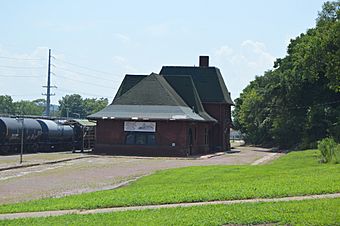Keokuk Union Depot facts for kids
Quick facts for kids |
|
|
Keokuk Union Depot
|
|
 |
|
| Location | 200 Exchange St. Keokuk, Iowa |
|---|---|
| Area | 1 acre (0.40 ha) |
| Built | 1890-1891 |
| Built by | Grace & Hyde Company |
| Architect | John Wellborn Root Herbert William Chamberlain |
| Architectural style | Romanesque Revival |
| NRHP reference No. | 13000109 |
| Added to NRHP | March 27, 2013 |
Keokuk Union Depot is an old train station in Keokuk, Iowa. It sits on the west bank of the Mississippi River. This historic building was built between 1890 and 1891. In 2013, it was added to the National Register of Historic Places. This means it's an important place to protect.
Contents
History of the Keokuk Train Station
Why a New Train Station?
In the late 1800s, railroads were growing fast. They wanted to move more goods and people. Before this depot was built, Keokuk had very poor train facilities. People even called them "shanties," meaning small, run-down huts.
To fix this, five different railroad companies joined forces. They created the Keokuk Union Depot Company. These companies were:
- Keokuk & Western Railroad
- St. Louis, Keokuk & Northwestern Railroad
- Chicago, Rock Island & Pacific Railroad (often called the Rock Island line)
- Toledo, Peoria & Western Railway
- Wabash Railroad
They wanted a much better station for their passengers and cargo.
Designing the Depot
The railroad companies hired a famous architect named John Wellborn Root. He was from the firm Burnham & Root in Chicago. Root designed the depot in the Romanesque Revival style. This was one of the last buildings he designed before he passed away. Herbert William Chamberlain, from the same firm, helped supervise the building work.
Busy Train Times
About ten years after the depot opened, two of the original railroads joined a bigger company. The Keokuk & Western and the St. Louis, Keokuk & Northwestern became part of the Chicago, Burlington & Quincy Railroad (CB&Q).
Keokuk Union Depot became a busy stop for famous trains. These included the Mark Twain Zephyr (run by CB&Q). It traveled between Burlington, Iowa and St. Louis. Another famous train was the Zephyr Rocket. This train was a joint effort by the CB&Q and the Rock Island line. It connected Minneapolis and St. Louis.
What Happened Next?
Passenger train service at the depot stopped in 1967. After that, the railroads used the building for their agents and operators.
In 1981, the Keokuk Junction Railway (KJRY) bought the local train tracks. They also bought all the shares of the Keokuk Union Depot Company. The KJRY then used the depot for their tourist train rides. They even offered trolley rides across the Mississippi River into Illinois.
Later, in 1996, a company called Pioneer Railcorp bought the Keokuk Junction Railway's assets. They used the old depot for storage until 2011. That year, they gave the depot and the land next to it to the City of Keokuk for 99 years.
The city then created the Depot Commission. This group helps manage and protect the building. The next year, a non-profit group called the Keokuk Union Depot Foundation was formed. Their goal is to raise money to save and run the depot for the future.
Architecture of the Building
The Keokuk Union Depot is built in a style called Late Victorian Romanesque Revival. It is made of brick with sandstone trim.
Key Features
The building has a unique, uneven shape. It features a peaked roof in the middle. You'll notice round-arched windows and door openings. The depot sits on a strong limestone foundation.
On the east side of the building, there's a steel canopy. This canopy has a curved roof. It runs along the entire length of the depot. This was built to protect passengers and freight from the weather.
Inside the depot, you can see strong oak beams supporting the roof. There's also a ticket booth built right into the wall. Restrooms were also included for travelers.
| Preceding station | Burlington Route | Following station | ||
|---|---|---|---|---|
| Montrose
toward Burlington
|
Burlington – St. Louis | Alexandria
toward St. Louis
|
||
| Preceding station | Chicago, Rock Island and Pacific Railroad | Following station | ||
| Sand Prairie
toward Oskaloosa
|
Oskaloosa – Keokuk | Terminus | ||



